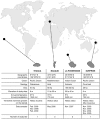Seabird modulations of isotopic nitrogen on islands
- PMID: 22723945
- PMCID: PMC3377609
- DOI: 10.1371/journal.pone.0039125
Seabird modulations of isotopic nitrogen on islands
Abstract
The transport of nutrients by migratory animals across ecosystem boundaries can significantly enrich recipient food webs, thereby shaping the ecosystems' structure and function. To illustrate the potential role of islands in enabling the transfer of matter across ecosystem boundaries to be gauged, we investigated the influence of seabirds on nitrogen input on islands. Basing our study on four widely differing islands in terms of their biogeography and ecological characteristics, sampled at different spatial and temporal intervals, we analyzed the nitrogen isotopic values of the main terrestrial ecosystem compartments (vascular plants, arthropods, lizards and rodents) and their relationship to seabird values. For each island, the isotopic values of the ecosystem were driven by those of seabirds, which ultimately corresponded to changes in their marine prey. First, terrestrial compartments sampled within seabird colonies were the most enriched in δ(15)N compared with those collected at various distances outside colonies. Second, isotopic values of the whole terrestrial ecosystems changed over time, reflecting the values of seabirds and their prey, showing a fast turnover throughout the ecosystems. Our results demonstrate that seabird-derived nutrients not only spread across the terrestrial ecosystems and trophic webs, but also modulate their isotopic values locally and temporally on these islands. The wealth of experimental possibilities in insular ecosystems justifies greater use of these model systems to further our understanding of the modalities of trans-boundary nutrient transfers.
Conflict of interest statement
Figures



References
-
- Polis GA, Anderson WB, Holt RD. Toward an integration of landscape and food web ecology: the dynamics of spatially subsidized food webs. Annu Rev Ecol Evol S. 1997;28:289–316.
-
- Sanchez-Piñero F, Polis GA. Bottom-up dynamics of allochthonous input: direct and indirect effects of seabirds on islands. Ecology. 2000;81:3117–3132.
-
- Stapp PG, Polis GA. Influence of pulsed resources and marine subsidies on insular rodent populations. Oikos. 2003;102:111–123.
-
- Ellis JC, Farina JM, Witman JD. Nutrient transfer from sea to land: the case of gulls and cormorants in the Gulf of Maine. J Anim Ecol. 2006;75:565–574. - PubMed
Publication types
MeSH terms
Substances
LinkOut - more resources
Full Text Sources

